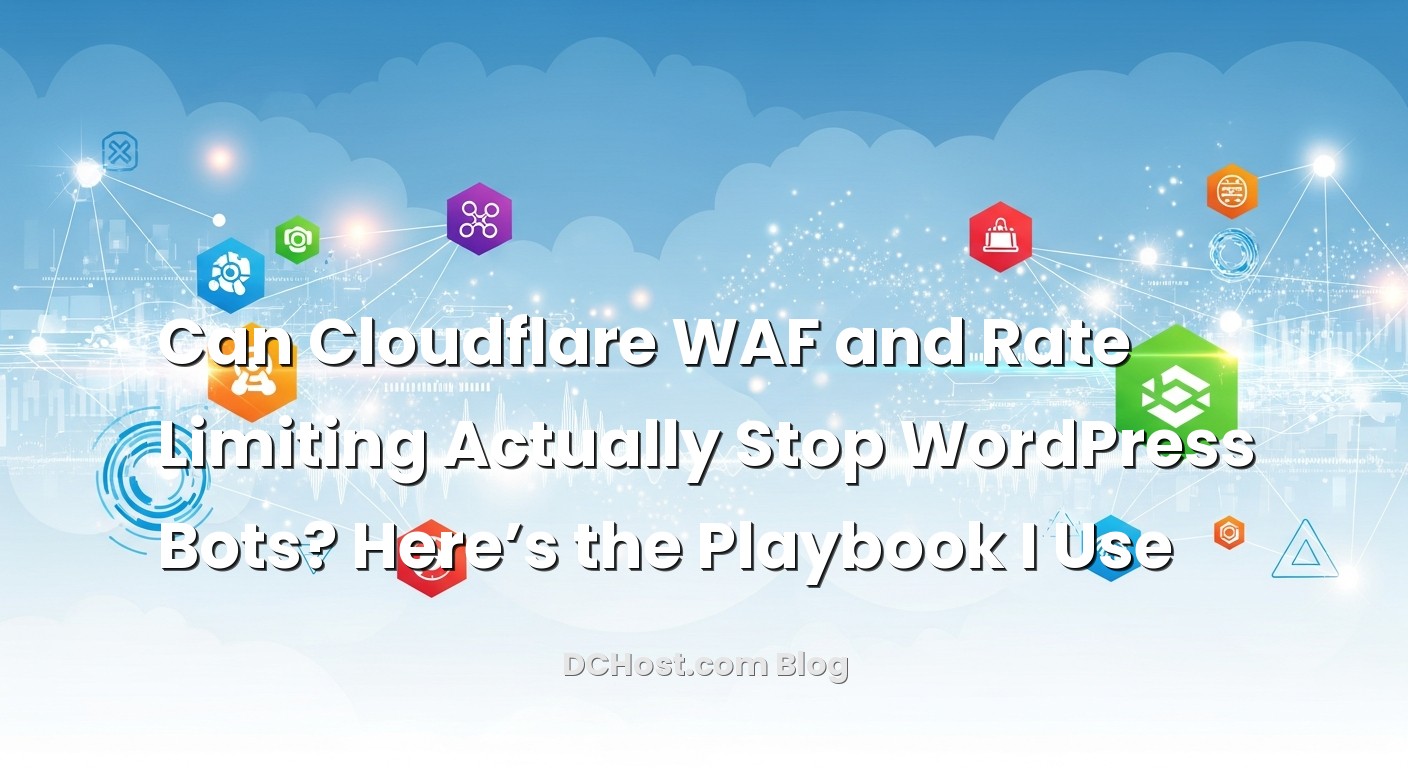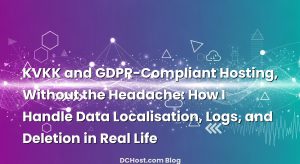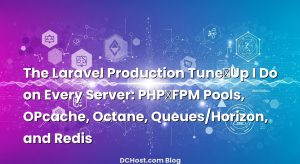So there I was, sipping a too-strong coffee, watching a client’s WordPress site crawl even though we had scaled the server more than enough. CPU looked fine. Database was healthy. No plugin gone rogue. But something felt off—those sneaky little spikes that make your graph look like a heartbeat monitor were exactly the kind that bots love to create. Ever had that moment when your WooCommerce checkout feels like it’s wading through molasses, even though real traffic is steady? That was the day I leaned fully into Cloudflare’s Web Application Firewall (WAF) and Rate Limiting as the front door bouncer. Not the bouncer who argues with your guests, but the one who quietly filters trouble before it ever gets to your lobby.
In this guide, I’ll walk you through how I protect WordPress and WooCommerce from abusive bots without breaking logins, payments, or APIs. We’ll talk about the annoying entry points bots love, the rule recipes I actually use, and how to tune rate limits so legit customers won’t ever notice. By the end, you’ll have a plan that feels like a friend showing you the ropes—not a manual written by a turnstile.
İçindekiler
- 1 Why WordPress Feels Like a Magnet for Bots
- 2 The Foundation: How Cloudflare Sees WordPress Traffic
- 3 The WordPress Entry Points Bots Love (And How I Treat Them)
- 4 My Go-To Cloudflare WAF Rule Recipes (In Plain Language)
- 5 Rate Limiting That Doesn’t Break WooCommerce
- 6 Testing, Observability, and The Tuning Loop
- 7 Real-World Gotchas (The Stuff I Learned the Hard Way)
- 8 Step-by-Step: A Friendly Setup You Can Copy
- 9 Frequently Overlooked Details That Make a Big Difference
- 10 A Story From the Trenches: The Store That Stopped Bleeding
- 11 Security Meets Performance: The Quiet Win
- 12 Wrap-Up: Your Friendly Checklist to Keep Bots in Their Lane
Why WordPress Feels Like a Magnet for Bots
I remember a client who swore they were hit by “DDoS attacks every day.” The funny thing? Most of what they saw wasn’t a DDoS at all. It was a thousand tiny cuts: login brute force attempts, XML-RPC abuse, fake cart updates, REST API probing, and even crawlers slamming the same endpoints over and over. None of it was glamorous. All of it was exhausting. And without a layer in front of WordPress, those annoyances become resource drains that look like outages from the inside.
Here’s the thing about WordPress: because it’s predictable, it’s also predictable for attackers. They know where to knock. /wp-login.php is always there. /xmlrpc.php is often left open. /wp-json/ frequently reveals more than you intend. And on WooCommerce sites, endpoints like cart fragments and admin-ajax can be abused to trigger expensive operations without buying anything. Think of it like a shop with clearly labeled doors—convenient for customers, obvious for troublemakers.
The magic of putting Cloudflare in front is that you gain a smart doorman who knows how to read the room. The WAF catches known bad patterns and the rate limiting rules keep repeat offenders from hammering the same doorbell all night. The trick is to combine them without making your real visitors solve puzzles or trip over blocks. Done right, it’s invisible.
The Foundation: How Cloudflare Sees WordPress Traffic
The traffic story in plain English
Before you write rules, you want to understand what Cloudflare can see and what WordPress expects. Cloudflare sits in front as a reverse proxy. Every request—whether from a browser, a bot, or a script—hits Cloudflare first. That means you can inspect path, country, ASN, method, headers, user agent, and even whether the visitor matches a verified search bot. It’s like having a metal detector on the door and a guest list in hand.
When I tune rules, I’m not aiming to block everything that looks unusual. I’m aiming to reduce cost per request. If a request is junk, drop or challenge it at the edge. If it’s likely real, let it flow. And if it’s suspicious, slow it down or push a managed challenge so that honest humans pass without friction.
What you should already be doing
Make sure your DNS is proxied (the little orange cloud should be on), your origin is locked down to only accept traffic from Cloudflare IPs if possible, and Cloudflare’s default managed WAF rules are enabled for WordPress. It’s also a good idea to log in to your WordPress dashboard and note what’s critical: login, checkout, REST endpoints used by plugins, webhooks, and any third-party integrations. You’ll protect those areas differently from your blog posts or static pages.
If you’re deep into performance too—and let’s be honest, security and performance are cousins—pairing proper caching with the WAF is a game-changer. If you haven’t yet, check out my walkthrough on CDN caching rules for WordPress and WooCommerce that won’t break your site. Caching the right stuff means fewer requests reach PHP in the first place, and your WAF and rate limits have less work to do.
The WordPress Entry Points Bots Love (And How I Treat Them)
1) wp-login.php: the all-you-can-eat buffet for brute force
There’s a reason login attempts spike after a post hits social. Attackers hope that someone reuses passwords or forgot to disable admin as a username. For /wp-login.php, I almost always combine two strategies: limit the frequency of POST requests and add friction for suspicious patterns. On Cloudflare, this means a WAF rule that challenges known-bad signals and a rate limiting rule that caps retries.
A realistic, low-friction approach: allow a few attempts, then challenge. Use a Managed Challenge instead of a full CAPTCHA—humans pass quickly; scripts typically fail. When you’re expecting higher admin activity (like a sale or a content blitz), dial thresholds gently upward to avoid frustrating your own team.
2) xmlrpc.php: legacy door, too many keys
XML-RPC is like the old service entrance nobody uses until they do. These days, many sites can disable it safely. Brute force via XML-RPC is still common because it allows batched attempts in a single request. So I usually block it outright unless there’s a specific, proven need. If you do need it (rare), wrap it in strict conditions and a tight rate limit.
3) REST API: convenient, chatty, easily poked
The REST API (/wp-json/ or /?rest_route=) is essential to modern WordPress. WooCommerce, page builders, and headless setups live there. The goal isn’t to block it; it’s to moderate it. Focus on methods and paths: GET on public endpoints is fine; repeated POSTs to sensitive routes should be watched closely. For WooCommerce stores, watch endpoints that touch carts, checkout, and session state through admin-ajax.
4) admin-ajax: the quiet workhorse that can still be abused
/wp-admin/admin-ajax.php powers a lot, especially in WooCommerce. Trouble is, it’s often called frequently, sometimes every few seconds. The trick is not to blanket-throttle it, but to look at action= parameters and the method being used. Read your plugin docs to know which actions are safe to throttle and which are mission-critical. Then craft rate limits that don’t smack real buyers in the face.
My Go-To Cloudflare WAF Rule Recipes (In Plain Language)
I’ve lost track of how many times I’ve stared at Cloudflare’s Firewall Events, piecing together a pattern like a detective with too many sticky notes. Let me spare you some of that with the rules I keep coming back to. Consider these “starting recipes.” You’ll tweak them based on your site’s traffic and plugins.
Protect login with a firm handshake, not a shove
Goal: slow brute force without punishing the one person who fat-fingered their password three times.
Cloudflare WAF expression idea:
(http.request.uri.path eq "/wp-login.php" and http.request.method eq "POST" and not cf.client.bot)Action: Managed Challenge. Optional add-ons: challenge only when cf.threat_score is high, or when the same IP hits multiple times quickly. Pair this with a separate rate limit rule (coming up) so repeat offenders get cooled off.
Block or quarantine xmlrpc.php
Cloudflare WAF expression idea:
(http.request.uri.path eq "/xmlrpc.php")Action: Block. If you truly must keep XML-RPC, consider changing the action to Managed Challenge and add a rate limit. Be wary of letting user-agent checks alone decide—those are easy to fake.
Lock down admin to known networks (when possible)
For teams with static office IPs or a VPN, this is the cleanest approach.
((http.request.uri.path eq "/wp-login.php") or (http.request.uri.path contains "/wp-admin")) and not ip.src in {YOUR_OFFICE_IPS_OR_VPN}Action: Block or Managed Challenge. If your team is remote with changing IPs, consider Cloudflare Zero Trust for identity-aware access to wp-admin. It’s extra setup but incredibly smooth once in place.
Keep REST API chatty but sane
I rarely hard-block /wp-json/. Instead, I challenge POSTs on sensitive routes if they come from sketchy countries or ASNs not typical for your audience. Start gently: challenge, log, and observe. Then tighten if needed.
Let verified bots through
Search engines, performance monitors, and integrations should flow without friction. Cloudflare offers a verified bots signal. In the WAF, I like to add “and not cf.client.bot” to my stricter rules. This avoids punishing Googlebot or legitimate crawlers unnecessarily. If you’re curious about the official bot lists and verification signals, Cloudflare’s docs on verified bots and good bot signals are a helpful reference when you need them.
Rate Limiting That Doesn’t Break WooCommerce
Rate limiting is where most people either underdo it (no limits at all) or overdo it (everyone gets blocked during checkout). The sweet spot is using different limits for different endpoints and methods. And yes, you’ll tune them a few times until it feels right. That’s normal.
General approach
Think of rate limiting like a speed bump, not a roadblock. A good rule slows down repetition and discourages scripts but still lets humans proceed. I like to use per-IP counters, small windows (like 30–60 seconds), and actions that escalate with behavior. First a managed challenge; then a block if the pattern won’t stop.
Login rate limit
Cloudflare Rate Limiting rule idea:
Expression: (http.request.uri.path eq "/wp-login.php" and http.request.method eq "POST")
Threshold: 10 requests per 60 seconds per IP
Action: Managed Challenge (or Block if you’re seeing heavy abuse)Tuning tip: if your organization has multiple admins behind one office IP, increase the threshold a bit. You can also carve an exception for your office IPs so your team never bumps into the speed bump.
xmlrpc.php rate limit (only if you can’t block)
Expression: (http.request.uri.path eq "/xmlrpc.php")
Threshold: 5 requests per 60 seconds per IP
Action: BlockMost sites can block XML-RPC entirely. If not, this rule helps prevent the batched login attack style that XML-RPC enables.
REST API and WooCommerce
WooCommerce storefronts need traffic flowing to /wp-json/, admin-ajax, and sometimes custom endpoints. The goal isn’t to cap overall API traffic; it’s to curb abusive patterns.
Expression: (http.request.uri.path contains "/wp-json/" and http.request.method in {"POST","PUT","DELETE"})
Threshold: 30 requests per 60 seconds per IP
Action: Managed ChallengeThis lets regular browsing and GET requests sail through while adding friction to scripts hammering cart or account actions. If you find a specific route abused (like a plugin endpoint), target it directly with a tighter threshold.
admin-ajax rate limits
admin-ajax is a blender for many plugins. Some actions are harmless and frequent, especially cart fragments. Others are computationally expensive. When I don’t know every action off-hand, I start with a broad rule for POST with a generous threshold, observe, and then narrow it down:
Expression: (http.request.uri.path eq "/wp-admin/admin-ajax.php" and http.request.method eq "POST")
Threshold: 120 requests per 60 seconds per IP
Action: Managed ChallengeAfter a week of logs, you’ll know which actions deserve stricter limits. Adjust those individually so you’re precise without crushing normal behavior.
Escalation with grace
On noisy days—like Black Friday—expect more everything. I usually switch rate limit actions from Block to Managed Challenge during big events. Humans breeze through; bots get stuck. If abuse is intense, escalate to short blocks only for the noisy endpoints while leaving the rest of the site friendly.
Testing, Observability, and The Tuning Loop
Start in Simulate mode
Cloudflare lets you preview what the WAF would have done without actually blocking traffic. I love this for the first week of a new ruleset. Launch new rules in Log or Simulate mode, watch the events, then switch to Challenge or Block once you’re confident.
Watch the Firewall Events like a hawk
There’s a story behind every spike. Open Cloudflare’s Firewall Events and look at what’s getting matched. Patterns jump out: same user-agent, same ASN, same URI. This also helps you prove to your team that the rules are helping rather than randomly punishing users. I often keep a dashboard open during the first 48 hours with filters for login, xmlrpc, admin-ajax, and wp-json.
Don’t punish the good bots
This is where verified bot detection is golden. If your rate limits or WAF rules hit Googlebot, review your expressions. Include allowances for cf.client.bot where appropriate. The official Cloudflare verified bots documentation explains how Cloudflare knows a crawler is legit. It’s worth skimming once, then codifying that exemption in your rules.
Log to origins when it helps
Sometimes you want to correlate a 403 in Cloudflare with a PHP log line. Turn on local logging or integrate analytics so you can follow a session’s story end to end. If you’ve got a separate monitoring tool for your origin, it’s satisfying to watch resource usage drop after a good WAF deployment.
Tune weekly, then monthly
Real talk: you’ll tweak rules more the first month than the next six. Traffic has seasons. After the training wheels come off, set a monthly reminder to review the top matched rules and see if thresholds need slight nudges. This habit keeps you ahead of new scraping patterns and plugin updates.
Real-World Gotchas (The Stuff I Learned the Hard Way)
WooCommerce checkout is sacred
I once saw a store experience “random” checkout failures. The culprit? An overzealous admin-ajax throttle. It’s tempting to crush everything with a big hammer, but checkout brings many background requests in a short window. Let your buyers glide through. If you rate-limit /wp-admin/admin-ajax.php, ensure generous thresholds and consider exempting checkout-specific actions. Watch the logs when a real customer checks out and note the pattern.
CDN caching and WAF are teammates
Security and caching complement each other beautifully. Cache the static and anonymous stuff as much as you can so your WAF mostly guards dynamic endpoints. If you’re not sure where to start, my CDN caching playbook for WordPress and WooCommerce walks through cache-control headers and safe bypasses so you won’t accidentally cache logged-in sessions or carts.
Don’t rely on user agents alone
Attackers fake user agents like it’s a hobby. “Googlebot” in the UA string doesn’t prove anything. Use Cloudflare’s verified bot signal where possible and look at behavior patterns rather than a single header.
Country blocks can be blunt instruments
Blocking entire countries sometimes sounds appealing, but legitimate buyers travel, and payment gateways or inventory feeds might route through places you didn’t anticipate. If you must geo-block, do it only for admin and login, not your entire site. Or use challenges for high-risk regions rather than outright blocks.
When to use Super Bot Fight Mode
Cloudflare’s bot features are powerful. If you turn on aggressive modes, test everything—especially admin-ajax and REST API heavy flows. When I enable extra bot fighting features, I prefer to use allow rules for known-good services first. Cloudflare’s docs on Bot Management and Super Bot Fight Mode are handy to skim before you flip big switches. Start gently; then dial up as you learn.
Reputation signals are helpful, not divine
Cloudflare’s cf.threat_score is useful for nudging suspicious traffic into challenges, but it’s not a judge and jury. Pair it with path-based logic. For public blog posts, I don’t care. For login and xmlrpc, I care a lot.
Step-by-Step: A Friendly Setup You Can Copy
1) Turn on Cloudflare managed WAF rules
Enable the managed rulesets designed for common CMS patterns and WordPress. Leave default actions as-is at first. This gets you baseline protection with minimal fuss. Cloudflare’s managed rulesets overview is worth a bookmark when you’re curious about what’s under the hood.
2) Add your custom WordPress rules
Start with three high-impact rules:
Rule A: Managed Challenge for POST to /wp-login.php, excluding verified bots and optionally exempting your office IPs.
Rule B: Block /xmlrpc.php outright. If you truly need it, challenge and rate limit instead.
Rule C: Restrict /wp-admin and /wp-login.php to known IPs or require an identity challenge via Cloudflare Access if your team is distributed.
3) Add rate limits where they matter
Start with:
Rate Limit 1: /wp-login.php POST, threshold around 10 requests per 60 seconds per IP, Managed Challenge.
Rate Limit 2: /xmlrpc.php any method, threshold around 5 per 60 seconds, Block.
Rate Limit 3: /wp-json/ for write methods (POST/PUT/DELETE), threshold around 30 per 60 seconds, Managed Challenge.
Optional Rate Limit 4: /wp-admin/admin-ajax.php POST, threshold around 120 per 60 seconds, Managed Challenge. Then refine by action parameter once you see what’s noisy.
4) Test with real flows
Log out. Try to log in with a wrong password a couple of times. Check if you’re getting challenged after your threshold. Add a product to the WooCommerce cart, proceed to checkout, and complete a test order. Watch the Firewall Events and Rate Limiting analytics during these actions. If you don’t see any events where you expect them, your expressions might need small corrections.
5) Observe and adjust
For the first week, expect to tweak thresholds slightly. If a rule never triggers, it’s either not needed or it’s too strict to match legitimate patterns. If it triggers constantly, raise the threshold or move from Block to Managed Challenge. Your goal is to get a calm dashboard with clear wins on the abusive patterns.
Frequently Overlooked Details That Make a Big Difference
Whitelist your own services
Payment gateways, inventory connectors, and uptime monitors might not be “verified bots,” but you rely on them. If they hit admin-ajax or webhooks frequently, add an allow rule for their IPs or user agents combined with other identifying markers. Do this early so your logs don’t fill up with false positives.
Keep WordPress itself healthy
No WAF can fix a site that’s already struggling. Update plugins and themes, remove abandoned ones, and ensure login URLs aren’t publicly linked in navigation. If you’re using a security plugin, make sure it’s not fighting Cloudflare or duplicating work in a way that adds friction for real users.
Consider Turnstile for the login page
If you want a human-friendly check without the old-school CAPTCHA pain, Cloudflare Turnstile is worth testing. It plays nicely with Managed Challenges and gives you another layer of defense on the login screen without spamming users with puzzles.
Set expectations with your team
Tell your editors and support staff, “If you ever see a challenge page on login, let me know.” It takes the mystery out of the occasional bump and gives you quick feedback if a rule is too strict. I’ve avoided many “the site is down!” Slack pings just by explaining what a challenge means.
A Story From the Trenches: The Store That Stopped Bleeding
One WooCommerce shop I work with had a weird pattern. Every few hours, CPU would spike and PHP workers would max out for a few minutes, then everything would calm down. Visitors felt the slowdown but analytics didn’t show surges in real traffic. We traced it to a scrape on the REST API where a bot was hammering a couple of product routes and triggering cart actions like clockwork. Nothing glamorous—just relentless.
We added two rules: a rate limit for POST on /wp-json/ and a WAF challenge on specific cart-related admin-ajax actions. I kept the actions light at first because I didn’t want to break checkout. Within a day, the spikes vanished. Legit buyers never noticed a thing. The owner messaged me, “I didn’t realize bots could be this quiet and still cause so much pain.” Honestly, that’s the point—bad traffic doesn’t always look like a storm. Sometimes it’s a slow drip, and Cloudflare is the valve you tighten.
Security Meets Performance: The Quiet Win
Here’s what happens after a few weeks with good WAF and rate limits: your origin metrics get boring in the best way. Fewer PHP spikes. Fewer panic alerts. Checkout remains smooth even during promotions. And yes, your hosting bill might even flatten a bit because you’re simply doing less work for nonsense. It’s not glamorous, but it’s incredibly satisfying.
And if you’re pairing this with caching, it’s a double win. Put the heavy lifting on the edge, reserve PHP for real work, and let the WAF be your steady guardian. If you’re curious how caching policies and bypass rules fit into the bigger picture, I break down the practical details in my guide to CDN caching that just works for WordPress and WooCommerce.
Wrap-Up: Your Friendly Checklist to Keep Bots in Their Lane
Let’s land this plane. Cloudflare’s WAF and Rate Limiting work best when they feel like a polite, consistent doorman. You’re not picking fights. You’re quietly reducing waste. Start by guarding the obvious doors—wp-login.php, xmlrpc.php, and sensitive REST API and admin-ajax flows. Use Managed Challenges generously and Blocks sparingly at first. Let verified bots pass, and give your own services a hall pass. Then watch the logs and nudge thresholds until things hum.
If you’ve been living with random slowdowns, suspicious login spikes, or API drips that never seem to end, this setup can make your site feel calm again. Couple it with clean plugin hygiene and smart caching, and you’ll wonder why you waited so long. Hope this was helpful! If you try these rules and get stuck, shoot me a note on what endpoint is giving you trouble—chances are we’ve all wrestled with it at some point. See you in the next post, where we’ll dig into another small tweak that makes a big difference.





